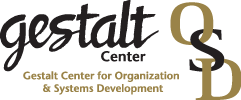INTENTIONAL LEADERSHIP; KEYS TO EFFECTIVE USE OF SELF
GestaltOSD as a body of knowledge: Sometimes referred to as "The House", "Naturalpathchange", or "Black Gold"
In our body of knowledge we use the Circle, representing the Cycle of Experience, to assess the natural processes of change and interruptions to change/contact. We use the Triangle or Six Triangles to assess important aspects of reality often left out of each person’s conceptual models. We use the Square to assess types of change as well as Stages and Phases of Development. A Line represents for us a Unit of Work, the conceptual model we use to assess and support orchestrated change.
The entire construction of the house is based upon natural human processes. Everything represented by the conceptual frames of reference already exists within each individual. The awareness, knowledge and skill represented by the body of knowledge are available to you and only require practice, practice and more practice. The efficacy of the body of knowledge has been tested by thousands of individuals from around the world.
The foundation of our house is the integrated body of knowledge we call GestaltOSD. It is a combination of theory, concept, method, tool and technique. It integrates systems thinking, organization development theory and concept, and Gestalt perception theory. GestaltOSD is an integrated body of knowledge that can be used to support most other theory, concept and method. It supports you to do what you do – only you do it better. The key is that all our theory, concepts and methods mirror natural human processes; already existing is all human systems.
The floor of the house is created by each individual’s figure/ground formation, (perception). Each individual scans his or her internal and external environment (context), and makes meaning, allowing the mobilization of energy and action to resolve tension and meet desired outcomes.
One’s perception is significantly influenced by the level or levels of system they include in their scan. The ground and figures are also informed by their “I”, “We”, or “It” orientation.
The four supporting pillars in the house (conceptual frames of reference) are
1) The cycle of experience for making meaning of the natural process of change
2) Unit of Work for making meaning of orchestrated change
3) Types of change representing four different perspectives
4) Six triangles used to identify where and how to focus one’s attention when supporting organization change

The fifth and central pillar is Carters’ Cube, a conceptual frame of reference used to support meaning making at various stages and phases of development and at all levels of system. Stage and phase phenomenon are often primary structures and processes that support or inhibit change. We view structures as processes or boundaries that have become inflexible or perceived as permanent or rigid.
The walls of the house are the forces for sameness, resistances, in the system, the habitual patterns used to meet the system needs. For example: We want to work as a team yet each of us wants to maintain our autonomy. Some walls are experiments, put in place to see what happens and to test whether they create change in a desired direction. For example, walls might be created to make a house very sturdy and at the same time to feel open and light. A theme statement of the current reality reflects both what is wanted and what is being avoided. In the individual a theme embodies both forces for change and forces for sameness. "The house" is very open to the outside environment and very solid and safe. "The house" makes it very easy for an individual to feel very grounded and centered.
The roof of the house is the paradoxical theory of change. This over-arching theoretical perspective states:
“A system becomes conscious of alienated fragments within and without so it can bring them into the main functional activities. There is awareness within the system that an alienated fragment exists; next that fragment is accepted as a legitimate outgrowth of a functional need and given power to operate as an explicit force. This leads to communication with other subsystems and facilitates an integrated, harmonious development of the whole system” (Arnold Beisser).
To fully understand the individual, group or organization you are working with, you must be able to see the system as perfect as it is, no matter how flawed. We believe any individual, group or system is behaving the best it can at any particular moment in time.
Our experience shows us that this knowledge exists within each individual. The Gestalt OSD body of knowledge involves phenomenon that you have likely observed and experienced throughout your life without having a name for it or realizing the significance of its existence or its place in the change process. You may or may not be aware of these processes within you. You probably use different language to describe many of the processes. Your unique way of describing these human processes is your Gestalt, your theory, concept and method you use to make meaning of everyday experience. GestaltOSD is the body of knowledge we have created to support enhancing self- mastery. Through our individual self-mastery we are able to transform humankind.

